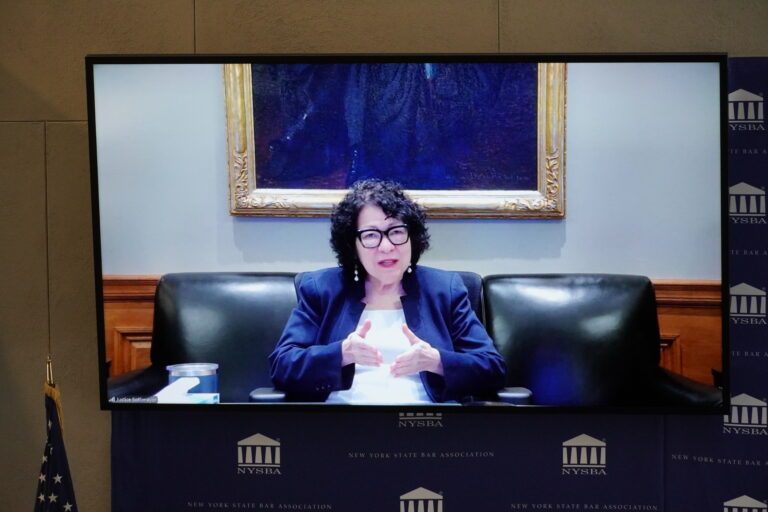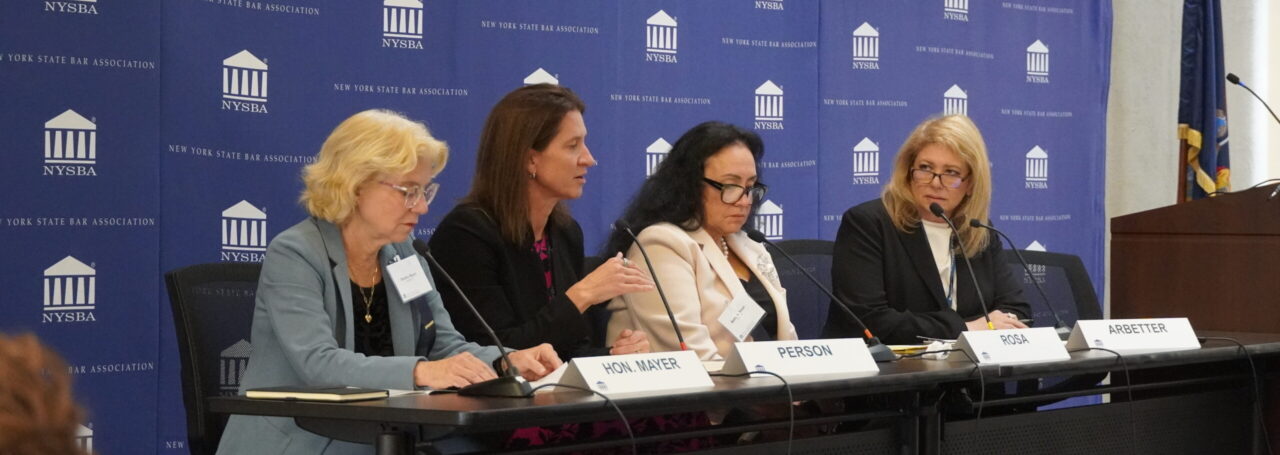U.S. Supreme Court Justice Sonia Sotomayor Speaks With Students at New York State Bar Association Civics Convocation
5.13.2024

U.S. Supreme Court Justice Sonia Sotomayor shared wisdom, advice and anecdotes with high school and college students at the New York State Bar Association’s Civics Convocation – a daylong event to promote and advance civic education in New York State.
Justice Sotomayor, who appeared virtually, answered questions from 10 students from three high schools – Albany High School, Bethlehem High School and Shenendehowa High School – and three colleges – St. Bonaventure University, SUNY Fredonia and Cornell University.
Watch video of the full session here.
“We adults have not done a very good job at solving the world’s problems,” she told the students. “We have not created the world that I had wanted to create when I was your age… I have hope because you young people have an opportunity to do a better job than we have. You have a chance with your energy and your ideas to imagine a better world than the one we have created. You can only do that by education, by learning about civics, by learning about your government and how you can effect change. But more importantly you can do it with your energy, with your desire and passion to build that better world.”
Zoey Volmer, a 12th grader at Albany High School, asked about social media as a way to observe civic discourse, a question inspired by her own studies. Justice Sotomayor advised taking a media knowledge course due to the overwhelming amount of misinformation on the internet. “Media literacy should be a course in every high school today,” she said. “And if it’s not in your high school, you should be insisting that your school create it.”
Grace Hodara, a freshman at St. Bonaventure University, asked about how people can navigate the intersection between journalism and modern politics while preserving truth and the integrity of democracy.
Justice Sotomayor advised going directly to the source – for example, reading Supreme Court decisions in full instead of relying on secondhand reports. “I fear that our citizenry is getting used to the old-tweet method of 150 words in communicating about complex ideas that we stop really thinking about in-depth each issue,” she said. “I am encouraging all of you to realize that it is important to look for both sides of an issue before you make a final decision. It is all too easy to think in black and white, but the world is not black and white; it’s filled with grey.”
Noting that not all the students intend to pursue careers in law, the Justice said that volunteer work could be part of any occupation.
Chief Judge Rowan Wilson of the New York State Court of Appeals introduced Justice Sotomayor. Christopher Riano, co-chair of the New York State Bar Association’s Presidential Task Force on the 2024 Civics Convocation and president of the Center for Civic Education, facilitated the discussion and introduced the students.
Speakers Argue for Involving Students in Civics
Justin Hubbard, a social studies teacher at Salamanca High School, spoke about how encouraging his students to have hard conversations and get involved in local issues led to increased involvement and collaboration in both the community and the government.
“At schools we have a responsibility to not only teach civics, but to do it in a way that empowers our youth and helps them find this common ground,” he said. “If we don’t address civics and politics in the classroom, our students are going to seek out other ways to get into these hard conversations. And what we know is the political socialization will then happen on social media, and social media radicalizes our students – it leads them to more polarization, more tribalism.”
Hubbard was the winner of the American Civics Education Teacher Award in 2022. Many of the students who asked Justice Sotomayor questions were his former students.
Other speakers struck a similar note. “We tend to put civics in a box in the classroom, but part of civic education needs to be what I would call contingent on that it creates spaces where young people are able to be heard, where young people are able to talk across differences and where young people are able to speak and connect,” said Verneé Green, chief executive officer of Mikva Challenge.
The theme of student engagement as a key to improving civic education continued during the day’s second panel that focused on such efforts throughout New York State.
“When you think about civics it should not be an isolated teaching process, but rather part of the total fabric of teaching, the math, the English. Every single part of the student’s life should be thinking about civility, thinking about issues of equity, thinking about issues of inclusivity,” said Betty Rosa, commissioner of education and president of the University of the State of New York.
The Civics Convocation was sponsored by the Committee on Law, Youth and Citizenship and financed in part by the New York Bar Foundation. Besides Riano, the other co-chairs of the convocation were Jay Worona, deputy executive director and general counsel for the New York State School Boards Association, and Gail Ehrlich, co-chair of the Law, Youth and Citizenship Committee.
New York State Bar Association President Richard Lewis appointed the task force that put on the convocation. “If we don’t have a collective understanding of how our government functions, it will be difficult – if not impossible – for us to play the very important roles of citizens in this democracy,” he said.






